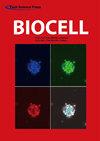Fang-Xia-Dihuang decoction inhibits breast cancer progression induced by psychological stress via down-regulation of PI3K/AKT and JAK2/STAT3 pathways: An in vivo and a network pharmacology assessment
IF 1
4区 生物学
Q4 BIOLOGY
引用次数: 0
Abstract
Background: The development and prognosis of breast cancer are intricately linked to psychological stress. In addition, depression is the most common psychological comorbidity among breast cancer survivors, and reportedly, Fang-Xia-Dihuang decoction (FXDH) can effectively manage depression in such patients. However, its pharmacological and molecular mechanisms remain obscure. Methods: Public databases were used for obtaining active components and related targets. Main active components were further verified by ultra-high-performance liquid chromatography-high-resolution mass spectrometry (UPLC-HRMS). Protein–protein interaction and enrichment analyses were taken to predict potential hub targets and related pathways. Molecule docking was used to understand the interactions between main compounds and hub targets. In addition, an animal model of breast cancer combined with depression was established to evaluate the intervention effect of FXDH and verify the pathways screened by network pharmacology. Results: 174 active components of FXDH and 163 intersection targets of FXDH, breast cancer, and depression were identified. Quercetin, methyl ferulate, luteolin, ferulaldehyde, wogonin, and diincarvilone were identified as the principal active components of FXDH. Protein–protein interaction and KEGG enrichment analyses revealed that the phosphoinositide-3-kinase–protein kinase B (PI3K/AKT) and Janus kinase/signal transducer and activator of transcription (JAK2/STAT3) signaling pathways played a crucial role in mediating the efficacy of FXDH for inhibiting breast cancer progression induced by depression. In addition, in vivo experiments revealed that FXDH ameliorated depression-like behavior in mice and inhibited excessive tumor growth in mice with breast cancer and depression. FXDH treatment downregulated the expression of epinephrine, PI3K, AKT, STAT3, and JAK2 compared with the control treatment (p < 0.05). Molecular docking verified the relationship between the six primary components of FXDH and the three most important targets, including phosphatidylinositol-4,5-bisphosphate 3-kinase catalytic subunit alpha (PIK3CA), AKT, and STAT3. Conclusion: This study provides a scientific basis to support the clinical application of FXDH for improving depression-like behavior and inhibiting breast cancer progression promoted by chronic stress. The therapeutic effects FXDH may be closely related to the PI3K/AKT and JAK2/STAT3 pathways. This finding helps better understand the regulatory mechanisms underlying the efficacy of FXDH.方霞地黄汤通过下调PI3K/AKT和JAK2/STAT3通路抑制心理应激诱导的乳腺癌进展:体内和网络药理学评估
背景:乳腺癌的发展和预后与心理应激有着复杂的关系。此外,抑郁症是乳腺癌幸存者中最常见的心理合并症,据报道,方霞地黄汤(FXDH)可以有效地治疗这类患者的抑郁症。然而,其药理和分子机制尚不清楚。方法:利用公共数据库获取有效成分及相关靶点。通过超高效液相色谱-高分辨率质谱(UPLC-HRMS)进一步验证了主要有效成分。蛋白质相互作用和富集分析用于预测潜在的枢纽靶点和相关途径。分子对接用于了解主要化合物与枢纽靶点之间的相互作用。此外,建立乳腺癌合并抑郁症动物模型,评估FXDH的干预效果,验证网络药理学筛选的通路。结果:共鉴定出174种FXDH有效成分和163种FXDH与乳腺癌、抑郁症的交叉靶点。槲皮素、阿魏酸甲酯、木犀草素、阿魏醛、木犀草素和双威草酮是FXDH的主要活性成分。蛋白-蛋白相互作用和KEGG富集分析表明,磷酸肌醇-3-激酶-蛋白激酶B (PI3K/AKT)和Janus激酶/信号转导和转录激活因子(JAK2/STAT3)信号通路在FXDH抑制抑郁症诱导的乳腺癌进展的作用中发挥了重要作用。此外,体内实验显示,FXDH可以改善小鼠的抑郁样行为,抑制乳腺癌和抑郁症小鼠的过度肿瘤生长。与对照组相比,FXDH处理可下调肾上腺素、PI3K、AKT、STAT3、JAK2的表达(p < 0.05)。分子对接验证了FXDH的6个主要成分与磷脂酰肌醇-4,5-二磷酸3-激酶催化亚基α (PIK3CA)、AKT和STAT3这3个最重要的靶标之间的关系。结论:本研究为FXDH改善抑郁样行为、抑制慢性应激促进乳腺癌进展的临床应用提供了科学依据。FXDH的治疗作用可能与PI3K/AKT和JAK2/STAT3通路密切相关。这一发现有助于更好地理解FXDH功效背后的调控机制。
本文章由计算机程序翻译,如有差异,请以英文原文为准。
求助全文
约1分钟内获得全文
求助全文
来源期刊

Biocell
生物-生物学
CiteScore
1.50
自引率
16.70%
发文量
259
审稿时长
>12 weeks
期刊介绍:
BIOCELL welcomes Research articles and Review papers on structure, function and macromolecular organization of cells and cell components, focusing on cellular dynamics, motility and differentiation, particularly if related to cellular biochemistry, molecular biology, immunology, neurobiology, and on the suborganismal and organismal aspects of Vertebrate Reproduction and Development, Invertebrate Biology and Plant Biology.
 求助内容:
求助内容: 应助结果提醒方式:
应助结果提醒方式:


